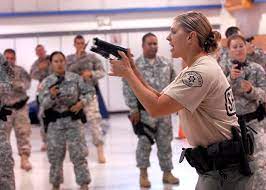One version of this article was published by Chicago Policy Review on January 19th of 2022. See: https://chicagopolicyreview.org/2022/01/19/soldiers-to-guardians-transition-to-a-community-policing-model/.

The murder of George Floyd, committed by a former Minneapolis Police Department (MPD) officer in an extremely gruesome and heinous fashion, caught the world’s attention and shed light on other unjust slayings. However, police killings are not new. Data collected by Statista suggests that over 1,000 known individuals were murdered by police officers in 2020 alone, of which 241 individuals were of the Black community, a group that constitutes only 14% of the total American population.
This disparity is evident in other areas of policing as well. According to Radley Balko, an award-winning journalist on policing, Black and Latino drivers were more frequently stopped for contraband searches even though officers had a higher chance of discovering illegal substance from a white driver. As measured by “daytime stops against nighttime stops” (skin color is less visible at night), traffic stops were more likely to be based on the drivers’ race as opposed to reasonably suspicious behavior of crime as is required by the Fourth Amendment (Balko, 2021). Systemic issues within the justice system including a lack of police accountability, qualified immunity that protects officers from being charged for their crimes, and the prevalence of military-style SWAT raids account for this disproportionality.
The warrior battleground training method widely deployed in police departments across the nation contributes to the prevalence of race-based police killings. Law professor Stoughton (2016) describes the warrior battleground as a mindset that teaches officers to imagine each civilian encounter as a life-or-death situation, encouraging officers to “control” the power dynamic and “dominate” the street. This pedagogy emphasizes honor, courage, and other ethos traditionally valued by soldiers, giving officers a philosophical grounding for treating community members as enemies. However, the warrior battleground training method is counter-intuitive as it fosters the escalation of conflict. This mindset increases the frequency of police shootings, lowers BIPOC communities’ trust in law enforcement, and is ineffective in controlling crime.
A direct remedy would be community policing, which emphasizes police-community relationship. The community policing model was used before the militarization of police departments in the ’60s (Balko 2014). Community policing is rooted in encouraging foot patrol rather than auto patrols: officers venture out of their cars, engage with community members, and prioritize remedying less severe crimes, such as petty thefts, to build a sense of community safety. Establishing a first-name basis with community members allows officers to know the community well enough to make reasonable judgments on crime, treat community members with respect, and enhance accountability in policing so that defying community expectations would lead to punishments. Under this model, communities are at the center of police behavior, and officers prioritize the needs and demands of the community.
The Urban Institute (2014) defined three pillars of community policing as “community partnerships, organizational transformation, and problem-solving”. Being service-oriented, this approach, which would apply to both officers and police executives, would prevent targeted crimes, emphasize communications with community leaders, integrate research into policing practice, and acknowledge citizen complaints about petty crime.
Although the idea and practice of community policing precedes the influential broken-window article by political scientists and criminologists Kelling and Wilson (1982), its development is unseparated from that piece. The broken window theory says one simple rule: for a community, norms of low expectations are signs of crimes. Kelling and Wilson believe that foot patrol work best to deter behavior that generates disorders. They noted that residents tended to be more fearful of these micro-crimes, such as graffiti, petty theft, or loitering, than violent crimes, such as robbery, drug trafficking, or homicide due to the rareness of the latter. The article has a major influence in modern policing and criminology scholars. First, they resonate with the principle that policing should prioritize community needs. Second, they imply that a strong police-civilian relationship is mutually beneficial— it helps officers perform their job and strengthens public trust in officers to lower crime rates. On the downside, the theory also fostered the popularity of extreme stop-and-frisk policy by NYPD, resulting in a skyrocketing increase in arrests of people for minor offenses. Additionally, Kelling and Wilson’s claims received little support from empirical research, which constantly found that targeting low-level crimes worked to increase the sense of public security but is not a great crime prevention strategy. If or not the theory works remains a question for the reader but what we do know that the theory has a longlasting legacy on the criminal-legal system and the community policing practice today.
The ultimate result of embracing community policing over warrior battleground training would be a significant drop in police violence and diminished racial inequality in policing. A transition in officer mentality from soldier to guardian will promote the saving of lives over the killing of lives.
Facing the aftermath of George Floyd’s death, we especially need to slow down and ponder what policing means. We must acknowledge that policing is a difficult and dangerous job; its very nature requires ensuring and valuing the safety of both officers and civilians. It is time to welcome a return of community policing in the nation.
References
Balko, Radley. Rise of Warrior Cop. New York: PublicAffairs, 2014.
Kelling, George L., James Q Wilson. “Broken Windows – The Police And Neighborhood Safety”. The Washington Post, last modified March, 1982. https://www.theatlantic.com/magazine/archive/1982/03/broken-windows/304465/.
La Vigne, Nancy G., Pamela Lachman, Shebani Rao, and Andrea Matthews. “Stop and Frisk: Balancing Crime Control with Community Relations.” Washington, DC: Office of Community Oriented Policing Services, 2014, accessed November 29th, 2021, https://www.urban.org/sites/default/files/publication/33661/413258-Stop-and-Frisk-Balancing-Crime-Control-with-Community-Relations.PDF.
“Number Of People Shot to Death By The Police In The United States From 2017 To 2021, By Race”. Statista, November 29, 2021, https://www.statista.com/statistics/585152/people-shot-to-death-by-us-police-by-race/.
Stoughton, Seth, W. “Principled Policing: Warrior Cops and Guardian Officers”. Wake Forest Law Review 51, (2016), accessed November 29, 2021, https://papers.ssrn.com/sol3/papers.cfm?abstract_id=2830642.
Tamir, Christine, Abby Budiman, Luis Noe-Bustamante and Lauren Mora. “Facts about the US Black Population”. Pew Research Center, last modified March 25, 2021, https://www.pewresearch.org/social-trends/fact-sheet/facts-about-the-us-black-population/.